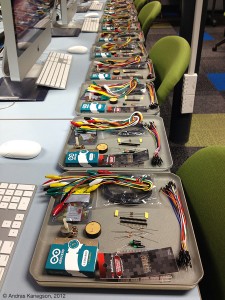By Scott Hutchinson, UCLA Extension Visual Arts
I was in a student-organized AIGA workshop in Los Angeles on Saturday, and was struck by a few things. (In addition to the name for the physical computing workshop: “Websites Suck, Make Something Real“)
First, the workshop looked different. Each workstation had a tray of carefully layed out wires, electronic parts, and an Arduino computer.
Second, while the workshop pulled in some of our regular AIGA student group crowd, this workshop audience was about a third – a first for me – middle school students. I’m guessing between 11 and 14 years old.
The workshop lead was Michael Newman, a painting grad from SVA that is extremely proficient with code, web and now art and electronics. Michael was kept on his toes by, of course, the kids, not simply in their technical ease, but rather in areas I think of as design thinking skills — creativity, excitement to play just for the thrill of learning, mixing and downloading source material, rapid prototyping, and collaborating with each other — seemed like just well worn and encouraged traits not always practiced in core design curriculm.

Instructor Michael Newman with a younger AIGA crowd (Photo: Andras Kanegson)

- Students in an AIGA workshop (Image: Andras Kanegson)
There is an opportunity to prepare for this thriving audience of young people. While design schools often only have a few experimental media classes in the DIY, maker and electronics space, it seems like the offerings are growing quickly and the integration of physical computing to design seems inevitable and exciting. The freedom to move beyond the constraints of computer, software, and traditional constructions and experiences was highly evident.
The lack of any easy description of what was going on also spoke to highly interdisciplinary programs for universities, and for AIGA. The proliferation of “Fab Labs” (Fabrication labs) is an example of some of the common creative spaces that are appearing more and more. I’d love to see an AIGA Fab Space. (Could you start in Los Angeles?)
I’m just old enough to remember the transition from traditional methodologies and production to digital production. Instructors often comment on the hand and tradition material skills partially lost in the transition. While there has been a clear re-integration of traditional and physical skills to the betterment of design, being at this workshop reminded me that the wires, chips and sensors inside the computer need to come out and be designed and played with as well.



